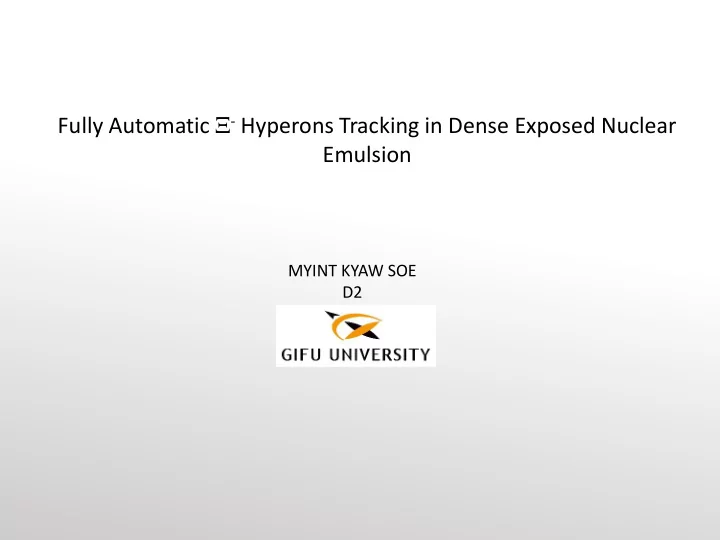

Fully Automatic X - Hyperons Tracking in Dense Exposed Nuclear Emulsion MYINT KYAW SOE D2
For information of L - L & X -N in S= -2 system; Double- L hypernuclei and X - hypernuclei are uniquely available sources Revisit to double- L hypernclear events 2/21
Among double- L hypernuclear events, NAGARA event is uniquely 0.17 MeV for L - L interaction [Ref: J. K. AHN et al., identified to be 0.67 PRC 88 (2013) 014003 ] In order to understand L - L interaction without nuclear core effect >> L - L interaction in different nuclear species To do so, E07 experiment will be carried out at J-PARC Production of S = -2 in nucleus Emulsion-Counter hybrid By following X - in emulsion with assist of SSD data, double - L hypernucleus will be detected 3/21
Ref: Propsal for K1.8 beam line at J-PARC, http ; / / j-parc.jp / researcher / E373 & E07 Hadron / en / pac_0606 / pdf / p07-Nakazawa.pdf (2006) In order to finish all X - candidates following in a few years and to reduce human-power, automatic X - tracking in nuclear emulsion plate is developed Motivation of this work 4/21
“Automatic X - tracking in dense exposed nuclear emulsion” Computer-aided Microscope System PC Camera Z Objective Lens Y Emulsion plate X 5/21
Flow of Method Track data (angle dx/dz, dy/dz, (x 0 ,y 0 ) from SSD or previous plate) 1. Track position estimation in emulsion 2. Correction of the track position 3. Plate to plate alignment 4. Emulsion surface detection 5. Track following #E373 emulsion plates are used to develop tracking system# 6/21
Track position estimation in emulsion Y Initial grid mark coordinate After photographic development X (E373 emulsion plate) Nega film Grid marks are printed at 1 cm intervals on emulsion plates (same in E07) By measuring coordinates of 9 grid marks of current emulsion plates after photographic development and they are mapped with initial grid coordinates Affine parameters are given and all tracks` positions are estimated by use of this parameters. 7/21
Correction of estimated track position 10mm One view of 50× microscope lens (125 m m × 130 m m) Followed track 10mm Grid mark Go and search near grid mark Take coordinate of this grid mark and get affine parameter Correct estimated track position Accuracy is 17.4 ± 9.2 m m Track exist within one view 8/21
Alignment of plate by plate connection with K - beam matching • Not enough for automated system Alignment with grid marks :: 17.4 ± 9.2 m m • Human assistance is required Y because many candidate tracks may exist in one view X beam spots One view of 50× objective lens (125 m m × 130 m m) For automated system, it is necessary about 1 m m alignment accuracy # K - beam pattern matching method is performed # 9/21
Gathering beam pattern from microscope image Superimposed and Take 7 micrographs Processed images Binarized image on both sides K- beams Plate.No i Z Plate.No i+ 1 10/21
Beam pattern matching Y in Plate No. i X In Plate No. i + 1 Demonstration of beam pattern matching Peak of 2D histogram becomes the offset ( D x, D y) 11/21
Automatic alignment was successful accuracy is less than 1 m m Position accuracy of alignment from 740 image samples dY dX 0. 57± 0.01μm 0. 82± 0.01μm This method is very important for automatic tracking system 12/21
Emulsion surface detection Charged particle tracks are visible only in emulsion layers It is important to distinguish between inside and outside of emulsion layers Upper layer Z Base It can be detected automatically by Down layer checking contrast of images along the optic Z- axis with the performance of image processing Micrograph inside of emulsion Micrograph outside of emulsion 13/21
Image processing Inside of emulsion Outside of emulsion 2 Contrast enhancement 1 Original image (micrograph) After image processing, the difference between inside and outside of emulsion 4 3 Background uniformity Gaussian filter ( - ) 3 2 14/21 5 Binarization
Number of white pixels are plotted along Z position Number of white pixels Take micrographs Upper layer Z Base Down Side Upper Side Down layer Threshold 500 Z( m m) Base 3 m m 500 m m Accuracy of automatic surface detection is 2.6±2.0 m m Sufficient for a fully automatic Image processing tracking system 15/21
Track Following Take 8 micrographs with interval of 6 m m Take images slightly shift with estimated angle (tan q) Upper side 6 m m Base Upper side Image processing 8 sheets Superimpose images Threshold banalization 16/21
Upper side Base Down side Take just one image in each estimated positions Shift length of dx, dy, dz are 2 2 dx dy θ tan calculated to be track range 40 2 dz m m Tracking in Down side is as same process as in Upper side 17/21
Track recognition in emulsion layer Acquired image 1 Cut track searching range 2 3 Track detection Make small mark Match small mark in cut range 18/21
Efficiency of track recognition as track angles (tan q ) # Development is ongoing # Misrecognition >> Compton electron in emulsion efficiency tan q 19/21
Video image for automatic X - tracking 20/21
Summary E07 experiment will be carried out at J-PARC to study S=-2 system with high statistics We expect X - stopping events (about 10 4 ) in nuclear emulsion from J-PARC E07 experiment In order to finish X - tracking work in a few year, automatic tracking system is developed All steps are almost finished with position accuracy in x and y axes: less than 1 m m and emulsion surface detection accuracy : about 2 m m. Development of track recognition is ongoing Thank you 21/21
40 m m dz q track 22
Back Up 23
Recommend
More recommend